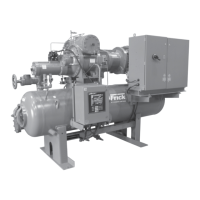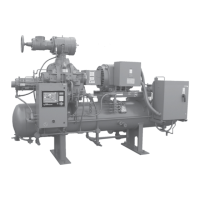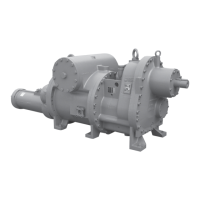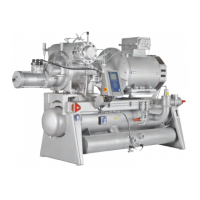RXF ROTARY SCREW COMPRESSOR UNITS
MAINTENANCE
070.410-IOM (JAN 12)
Page 29
Pressure Gauge - Discharge Port
1. High reading would indicate:
a. High viscosity and small and/or long discharge line.
b. Gate valve partially closed.
c. Filter plugged.
d. Vertical head did not consider a high specic gravity
liquid.
e. Line partially plugged from buildup on inside of pipe.
f. Liquid in pipe not up to temperature.
g. Liquid in pipe has undergone a chemical reaction and
has solidied.
h. Relief valve set too high.
2. Low reading would indicate:
a. Relief valve set too low
b. Relief valve poppet not seating properly.
c. Too much extra clearance.
d. Pump worn.
3. Fluttering, jumping, or erratic reading:
a. Cavitation.
b. Liquid coming to pump in slugs.
c. Air leak in suction line.
d. Vibrating from misalignment or mechanical problems.
Some of the following may also help pinpoint the problem:
1. Pump does not pump.
a. Lost its prime - air leak, low level in tank.
b. Rotating in wrong direction.
c. Motor does not come up to speed.
d. Suction and discharge valves not open.
e. Strainer clogged.
f. Relief valve set too low, relief valve poppet stuck open.
g. Pump worn out.
h. Any changes in the liquid system, or operation that
would help explain the trouble, e.g. new source of
supply, added more lines, inexperienced operators,
etc.
i. Tighten end clearance.
j. Head position incorrect.
2. Pump starts, then loses its prime.
a. Low level in tank.
b. Liquid vaporizing in the suction line.
c. Air leaks or air pockets in the suction line; leaking air
through packing or mechanical seal.
d. Worn out.
3. Pump is noisy
a. Pump is being starved (heavy liquid cannot get to pump
fast enough). Increase suction pipe size or reduce
length.
b. Pump is cavitating (liquid vaporizing in the suction
line). Increase suction pipe size or reduce length; if
pump is above the liquid, raise the liquid level closer
to the pump; if the liquid is above the pump, increase
the head of liquid.
c. Check alignment.
d. May have a bent shaft or rotor tooth. Straighten or
replace.
e. May be a foreign object trying to get into the pump
through the suction port.
4. Pump not up to capacity
a. Starving or cavitating - increase suction pipe size or
reduce length.
b. Strainer partially clogged - clean.
c. Air leak in suction piping or along pump shaft.
d. Running too slowly - is motor the correct speed and
is it wired up correctly
e. Relief valve set too low or stuck open.
f. Pump worn out.
g. Tighten end clearance.
h. Head position incorrect.
5. Pump takes too much power.
a. Running too fast - is correct motor speed, reducer
ratio, sheave size, etc. being used.
b. Liquid more viscous than unit sized to handle - heat
the liquid, increase the pipe size, slow the pump down,
or get a bigger motor.
c. Discharge pressure higher than calculated - check with
pressure gauge. Increase size or reduce length of pipe,
reduce speed (capacity), or get bigger motor.
d. Pump misaligned.
e. Extra clearance on pumping elements may not be
suf cient for operating conditions. Check parts for
evidence of drag or contact in pump and increase
clearance where necessary
6. Rapid Wear.
Examination of a pump that has gradually lost its ability to
deliver capacity or pressure would show a smooth wear pat-
tern on all parts. Rapid wear shows up as heavy grooving,
galling, twisting, breaking, or similar severe signs of trouble.
RECOMMENDED MAINTENANCE PROGRAM
In order to obtain maximum compressor unit perfor mance
and ensure reliable operation, a regular main tenance program
should be followed (see Maintenance Schedule):
The compressor unit should be checked daily for leaks, abnor-
mal vibration, noise, and proper opera tion. A daily log should
also be maintained. There should be a continued monitoring
of oil quality and oil analysis testing. In addition, an analysis
of the unit’s vibration should be made periodically.
VIBRATION ANALYSIS
Periodic vibration analysis can be useful in detecting bearing
wear and other mechanical failures. If vibration analysis is
used as a part of your preventive main tenance program, take
the following guidelines into considera tion.
1. Always take vibration readings from exactly the same
places, at exactly the same percent of load.
2. Use vibration readings taken from the new unit at start-up
as the base line reference.
3. Evaluate vibration readings carefully as the instrument
range and function used can vary. Findings can be easily
misinterpreted.
4. Vibration readings can be inuenced by other equipment
operating in the vicinity or connected to the same piping as
the unit. For additional information, request Frick
®
publica-
tion E70-902 IB.
OIL QUALITY and ANALYSIS
High quality refrigeration oil is necessary to ensure compres-
sor longevity and reliability. Oil quality will rapidly deteriorate
in refrig eration systems containing moisture and air or other
contaminants. In order to ensure the quality of the refrigera-
tion oil in the com pressor unit.
DO NOT MIX OILS of different
brands, manufacturers, or types.
Mixing of oils may cause excessive
oil foaming, nuisance oil level cutouts, oil pressure loss,
gas or oil leakage and catastrophic compressor failure.

